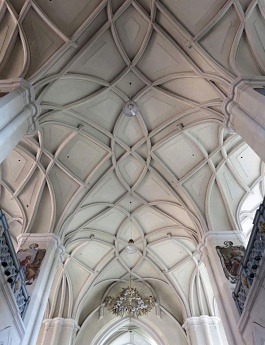
Two monuments from Vysočina are vying for the NPÚ Patrimonium pro futuro Award
 |
"The purpose of the award is to highlight positive examples and stories in the field of heritage care, to show what has been successful, and to recognize those who have contributed to it," the spokesperson stated. The national award is divided into four categories: heritage restoration and conservation, discovery or find of the year, presentation of values, and preservation of heritage.
The current form of the church of the Nativity of the Virgin Mary in the area of the national cultural monument of the Želiv Monastery is the work of Jan Blažej Santini-Aichel. It was built after 1714. The structure is considered one of the exceptional works of this architect in the Vysočina Region. Its furnishings, predominantly from the late Baroque period, consist of heritage-worthy elements of high artistic and craft quality.
The construction restoration of the church primarily involved the remediation of structural damage; it was also necessary to reinforce the Baroque roof structure. Repairs were made to the exterior and interior plaster, and the façade of the church and its interior spaces received new coatings. Work was carried out in parallel with the overall restoration of the church's furnishings and the two organs.
The fortress and farmstead in Sudkov Dole near Pacov are a well-preserved complex of buildings and archaeological finds that represent the typical development of a lower nobility residence from the Middle Ages to the 20th century. The entire area, along with the fortress dating from the turn of the 15th and 16th centuries, comprises a residential building and farm buildings from around the mid-19th century. The most valuable structure is the late Gothic tower fortress.
The fortress has a completely restored roof. The restoration of the plaster and repointing of the masonry was carried out using medieval lime technology. Due to the owners' willingness, the ancient fortress remains open to the public year-round and free of charge.
The English translation is powered by AI tool. Switch to Czech to view the original text source.
0 comments
add comment
Related articles
0
16.11.2022 | The heritage protectors appreciated the rescue of the Slovak Arrow and the restoration of the church in Fulnek
0
18.01.2021 | Vysočina has four new cultural monuments
0
05.11.2020 | The NPÚ assessed the colonnade in Luhačovice or the discovery of a medieval wall
0
02.10.2019 | NPÚ appreciated the rescue of the wooden house in Úpice and the Tomáš Baťa Memorial
0
16.07.2019 | People can vote for the winner of the Thanks to Heritage award until September 16
0
04.10.2018 | NPÚ appreciated the rescue of the Třebešice castle and the repair of the chapel in Návarov
0
03.10.2017 | Heritage conservators appreciated the rescue and restoration of churches and chapels
0
22.09.2016 | The Heritage Institute praised exemplary reconstructions
0
04.07.2016 | In the Vysočina region, two immovable cultural monuments have been added
0
15.04.2015 | The Santini Monastery Church in Želiv will be closed due to renovations
0
23.09.2014 | The Heritage Institute rewarded the owners of monuments with a new price
0
03.06.2014 | The Heritage Institute established an award for owners of cultural monuments












